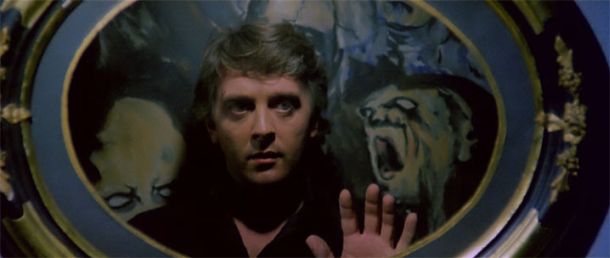
Deep Red might the most beautifully shot horror film ever made. The whole movie floats amid an array of rich color, sweeping camera movements, and lovingly designed sets that recall scenes from the devil's version of the Golden Age of Hollywood. Deep Red is hardly the only film by Dario Argento to share these qualities, but it might be the most confident and seamlessly executed. For all his visual gifts, Argento's films often suffer from uncomfortable editorial quirks and overly-jarring musical stings - things that take us out of an otherwise hermetic environment that only a visual perfectionist could have created. But Deep Red captivates from frame one, and I was never jostled out of the film's world by technical imperfections. The mood is consistently engaging, and although as a horror film it's not a terribly horrifying one, Argento's standard obsessions - innocent heroes, faceless sources of terror, washes of light, and, of course, flesh being stabbed and slashed by sharp things - are on full display.
A woman who claims to have extrasensory abilities is murdered in her apartment in Rome, while her neighbor, pianist Marcus Daly (David Hemmings), witnesses the attack from the street below. He proceeds to investigate the murder with the help of his gay friend Carlo (Gabriele Lavia) and a reporter named Gianna (Daria Nicolodi). Clues pile up - a creepy children's song, a missing painting from the dead psychic's apartment - leading Marcus to an old mansion that holds the key to the killer's identity and motive.
Hemmings is a brilliant casting choice. The heartless photographer turned tenacious detective from Blow-Up is re-cast here as an over-his-head musician with no aptitude for the supernatural - or for the rigors of a dangerous investigation, for that matter. Hemmings has the blank-faced intensity of the single-minded and, although he was famously accused by the Monty Python gang of being "a block of wood," his performance here is appropriately unflashy. But Marcus is driven - obsessed, even, by some of the same ideas with which Argento himself is preoccupied.
A telling - and very funny - scene in which Marcus angrily challenges Gianna to an arm-wrestling match tweaks the nose of the very English interest in following sets of pre-established rules at the same time that it reveals something about Argento's view of women and perhaps something about his proclivity for stories with female protagonists. Another regular Argento theme that runs through Deep Red is the notion of children and adolescents who witness something horrific at an impressionable age and the damage that it does to them over time - an idea present in Suspiria and others, but which relates directly to Deep Red's climax.
Argento's penchant for irregular pacing is not as evident in Deep Red, with the story unfolding at a relatively consistent rate, with set pieces spaced evenly - and, importantly, with enough exposition in between so that the plot feels cohesive. That is to say, Deep Red is more conventional in form than some of Argento's other films - for better or worse, it lacks that dream-state sensation that Argento excels at. The movie is generally rooted to its story. We never feel like we are floating away from it into a netherrealm only to learn that the story really never mattered in the first place. As such, Deep Red might make a good introduction to those who are new to the director's work.
Whatever one's assessment of the plot, which by itself is not particularly unique, Deep Red succeeds because of its visual accomplishments. Argento creates an alternate Rome where everyone speaks English - well, it's not Rome at all, really, but a bizarre Anglo-pean hybrid movieworld where things work as they do because Argento wants them to. But we see beyond the contrivances because Argento's vision is so unique and his imagery so memorable and convincing.

No comments:
Post a Comment